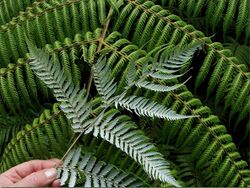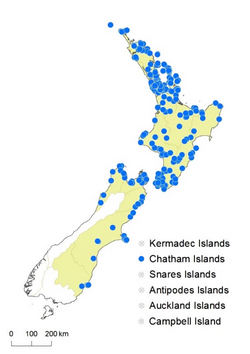Biology:Cyathea dealbata
| Silver fern | |
|---|---|

| |
| Frond, showing silver underside | |
| Scientific classification | |
| Script error: No such module "Taxobox ranks".: | <div style="display:inline" class="script error: no such module "taxobox ranks".">Plantae |
| Script error: No such module "Taxobox ranks".: | <div style="display:inline" class="script error: no such module "taxobox ranks".">Pteridophyta |
| Script error: No such module "Taxobox ranks".: | <div style="display:inline" class="script error: no such module "taxobox ranks".">Pteridopsida |
| Script error: No such module "Taxobox ranks".: | <div style="display:inline" class="script error: no such module "taxobox ranks".">Cyatheales |
| Script error: No such module "Taxobox ranks".: | <div style="display:inline" class="script error: no such module "taxobox ranks".">Cyatheaceae |
| Script error: No such module "Taxobox ranks".: | <div style="display:inline" class="script error: no such module "taxobox ranks".">Cyathea |
| Script error: No such module "Taxobox ranks".: | <div style="display:inline" class="script error: no such module "taxobox ranks".">Cyathea |
| Script error: No such module "Taxobox ranks".: | <div style="display:inline" class="script error: no such module "taxobox ranks".">Alsophila |
| Script error: No such module "Taxobox ranks".: | <div style="display:inline" class="script error: no such module "taxobox ranks".">C. dealbata |
| Binomial name | |
| Cyathea dealbata (G. Forster) Swartz, 1801
| |

| |
| Synonyms | |
| |
Cyathea dealbata, commonly known as the silver fern[1] or silver tree-fern,[2] or as ponga /ˈpɒŋə/ or punga /ˈpʌŋə/ (from Māori kaponga or ponga),[note 1] is a species of medium-sized tree fern, endemic to New Zealand. The fern is usually immediately recognisable by the silver-white colour of the under-surface of mature fronds. It is a symbol commonly associated with the country both overseas and by New Zealanders themselves.[3]
Description
This fern is known to grow to heights of 10 metres (33 ft) or more (though it occasionally takes a rare creeping form). The crown is dense, and mature fronds tend to be about 4 metres (13 ft) long and have a silver-white colouration on the undersides. This distinctive silver colouration has made them useful for laying along tracks for night walking. The scales are a dark brown and are often twisted and glossy.[4] Rhizomes very rarely prostrate, usually erect, forming a woody trunk up to 12 metres (39 ft) tall, 160 to 450 millimetres (6.3 to 17.7 in) in diameter, covered in light brown or white projecting stipe bases; bearing scales near the apex.[5]
Habitat
Arriving relatively late in New Zealand's history during the Pliocene epoch[6] (around 5.0–1.8 million years ago), the silver fern occurs on the main islands of New Zealand—although absent from the west and south regions of the South Island[7]—and on the Chatham Islands to the east. Its primary habitat is subcanopy areas of drier forests and in open scrub, although it is occasionally found on bush margins and in more open areas, and has been recorded from amongst rushes in a dune slack.
The fern is known to grow well in well-drained humus, and once established, it will tolerate drier conditions.[citation needed] It does best when sheltered from winds and should be protected from frost.
In culture

The earliest use of the silver fern as an official emblem was by the New Zealand Army during the Second Boer War. Since then, the silver fern has been used by the New Zealand Expeditionary Force during both world wars, and all Commonwealth war graves of fallen New Zealand soldiers have the silver fern engraved on their tombstones. During the 1956 Suez Crisis, Egyptians took exception to New Zealand and Canadian peacekeepers having the Union Flag on their uniforms. Canadian troops wore the Maple Leaf whereas the New Zealand contingent wore a silver fern symbol. New Zealand peacekeepers have since used both the silver fern and kiwi symbols for different deployments to differentiate from their Australian and British counterparts.[citation needed]
The silver fern has long been used on dairy products, including the logo of New Zealand Natural, and was trademarked as early as 1885.[citation needed] It is a logo for many other organisations, such as (heavily stylised) the rail operator KiwiRail. The Silver Fern is also the name of a class of railcar.[8]
Silver fern leaves appear on the coat of arms of New Zealand.[9] Some alternative flags for New Zealand, such as the silver fern flag, utilise the silver fern. The official proposal of the New Zealand flag referendums, 2015–16 featured the fern.[10] The silver fern is also used extensively within politics and printed material, such as the logo of the New Zealand Labour Party.[11]
The koru symbol is inspired by the shape of an unfurling silver fern frond. It is found extensively in Māori art, from carving to the official Māori flag, and is used in a stylised form as the logo for national airline Air New Zealand.[12] Its circular shape conveys the idea of perpetual movement, and its inward coil suggests a return to the point of origin.[13]
In short, the fern has become one of the most widely recognised symbols of New Zealand, next to the kiwi—however, it is not an official national symbol.[3]
-
The rejected silver fern flag proposal of the 2015 flag referendum
-
An Air New Zealand ATR 72-600 with a stylised koru on the tail and otherwise painted in all black livery with a silver fern on the fuselage.
-
An All Blacks jersey from 1905, featuring a silver fern
Use in sport
The silver fern has been used as a symbol by New Zealand national sports teams, in various stylised forms, since it was first worn by players in the 1888–89 New Zealand Native football team which toured Britain.[14] "Silver Ferns" is the name of the national netball team, and most other national women's sports teams have nicknames based on the term "Ferns", such as Black Ferns (women's rugby union), Tall Ferns (women's basketball) and Football Ferns (women's association football).[3]
National sport teams using the silver fern include:
- All Blacks (rugby)
- Silver Ferns (netball)
- All Whites (football)
- Tall Blacks (basketball)
- White Ferns (women's cricket)
- Black Caps (men's cricket)
- Black Ferns (women's rugby)
- Black Sticks Men & Black Sticks Women (field hockey)
- Team New Zealand (sailing)
- Iron Blacks (American Football)
The silver fern is also extensively used as part of the official symbols of New Zealand Olympics teams.[15]
Controversy
In 1991, the New Zealand Rugby Football Union obtained trade marks for the name “All Blacks” and its own stylised fern, however the scope of the application was broader because they sought to register any 'fern'. In 2005, after a legal case lasting four years, the union failed in its bid to stop anyone else using any fern logo on any black jersey.[16]
Footnotes
References
- ↑ Brownsey, Patrick (24 September 2007). "Ferns and lycophytes - Ferns and lycophytes in New Zealand". Te Ara - the Encyclopedia of New Zealand. https://teara.govt.nz/en/photograph/10881/silver-fern. Retrieved 12 October 2018.
- ↑ "BSBI List 2007" (xls). Botanical Society of Britain and Ireland. http://www.bsbi.org.uk/BSBIList2007.xls. Retrieved 2014-10-17.
- ↑ 3.0 3.1 3.2 "Government and nation - National animal and flower". The Encyclopedia of New Zealand. 3 March 2009. http://www.teara.govt.nz/en/government-and-nation/9. Retrieved 16 February 2010.
- ↑ Large, M. F.; Braggins, J. F. (2004). Tree Ferns. Timber Press, Inc.. pp. 120–121. ISBN 0-88192-630-2.
- ↑ "Flora of New Zealand | Taxon Profile | Cyathea dealbata" (in en). http://www.nzflora.info/factsheet/taxon/Cyathea-dealbata.html. Retrieved 11 October 2018.
- ↑ Parsons, Stuart (2006). Biology Aotearoa. Pearson Education New Zealand. ISBN 1-877268-00-3.
- ↑ "The significance of the silver fern" (in en). 6 June 2017. https://www.tepapa.govt.nz/discover-collections/read-watch-play/maori/significance-silver-fern. Retrieved 13 October 2018.
- ↑ "Silver Fern railcar". Ministry for Culture and Heritage. 16 October 2014. https://nzhistory.govt.nz/media/photo/silver-star. Retrieved 12 October 2018.
- ↑ Levine, Stephen (12 June 2012). "Coat of arms - Coat of arms overview". e Ara - the Encyclopedia of New Zealand. https://teara.govt.nz/en/ephemera/35051/new-zealand-coat-of-arms. Retrieved 12 October 2018.
- ↑ "NZ confirms flag referendum candidate". BBC News. 15 December 2015. https://www.bbc.co.uk/news/world-asia-35090641. Retrieved 12 October 2018.
- ↑ "Register of Political Parties" (in en). Electoral Commission. https://www.elections.org.nz/parties-candidates/registered-political-parties/register-political-parties. Retrieved 12 October 2018.
- ↑ Wedde, Ian (2005) (in en). Making Ends Meet: Essays and Talks, 1992-2004. Victoria University Press. p. 187. ISBN 9780864735034. https://books.google.co.uk/books?id=1uQzBzQPfnkC&pg=PA187.
- ↑ Walrond, Carl. "The koru". Te Ara - The Encyclopedia of New Zealand. https://teara.govt.nz/en/photograph/2422/the-koru. Retrieved 12 October 2018.
- ↑ Wilson, John (16 September 2016). "Nation and government - Nationhood and identity". Te Ara - the Encyclopedia of New Zealand. https://teara.govt.nz/en/photograph/2579/wearing-the-silver-fern. Retrieved 12 October 2018.
- ↑ Strang, Ben. "The history of black: Why do Kiwi sports teams wear black and when did it start?" (in en). Stuff.co.nz. https://www.stuff.co.nz/sport/olympics/82035787/the-history-of-black-why-do-kiwi-sports-teams-wear-black-and-when-did-it-start. Retrieved 11 October 2018.
- ↑ "NZRU bid for silver fern rights thrown out". The New Zealand Herald. 14 December 2005. http://www.nzherald.co.nz/nz/news/article.cfm?c_id=1&objectid=10359885. Retrieved 11 April 2015.
External links
- The International Plant Names Index: Cyathea dealbata
- Definitive scientific account of Cyathea dealbata — Te Papa for Flora of New Zealand
Wikidata ☰ Q1248008 entry



